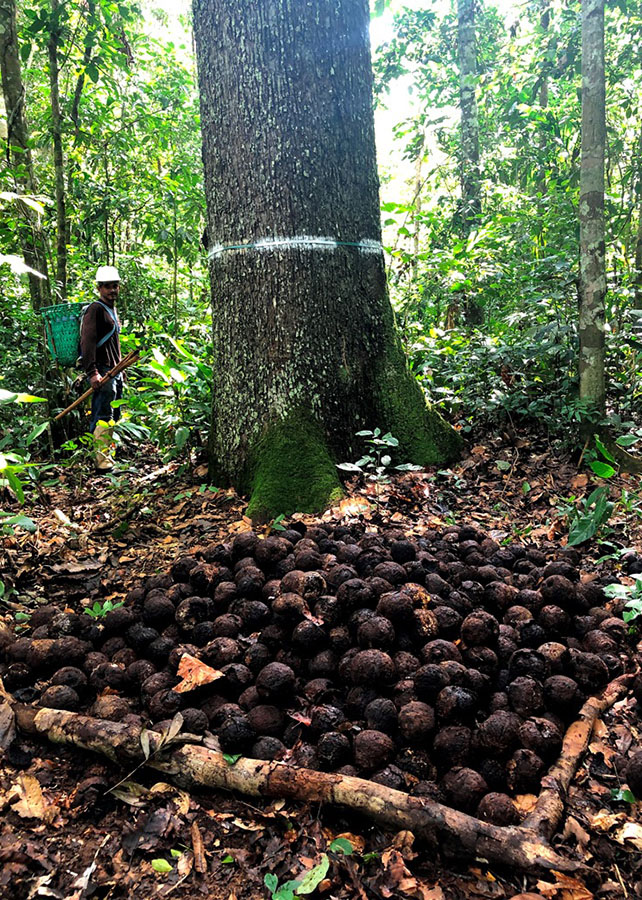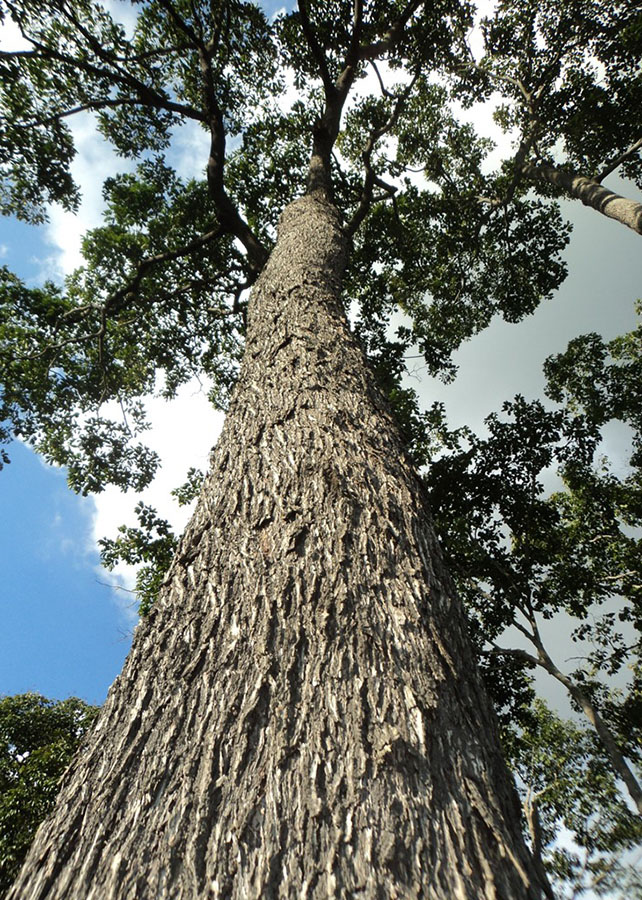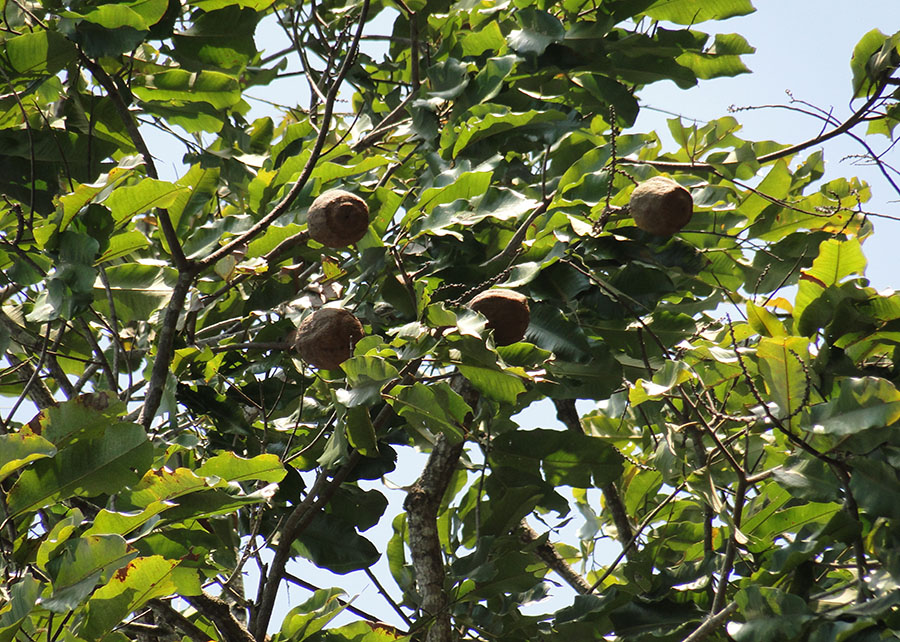The same tree shows different production from one year to the other, which also occurs among individuals in the same location. Elucidating the reason for the variations is fundamental for thousands of families who make a living from the extraction of Brazil nuts (a.k.a. Amazon nuts or Pará nuts) Researchers have found that the dry season is an important factor that influences nut production, as it is the period the species starts to flower. The terrain also influenced production; trees at higher altitudes bore more fruit than those located in lower regions. A higher amount of phosphorus and potassium in the soil is also directly related to increased production. The findings were published by the periodical Nature Scientific Reports. Factors such as terrain, variation in air vapor pressure and climate change influence the production of Brazil nut (Bertholletia excelsa Bonpl.). fruits. The discovery is based on research conducted by scientists from Embrapa, the Federal University of Acre (Ufac), in Brazil, and the U.S. universities of Alabama (UA) and Florida (UFL). or ten years, they monitored and recorded the natural production of fruits in 258 century-old Brazil nut trees distributed in two communities in Acre state: Chico Mendes Extractive Reserve and Chico Mendes Agroextractivist Settlement Project. The work was published in the journal Nature, in the paper "Comparative models disentangle drivers of fruit production variability of an economically and ecologically important long-lived Amazonian tree". Trading the tree's product, the Brazil nut (or Amazon nut), supplements the income of thousands of families in Northern Brazil. The team applied a mathematical model that identified how production variation related to its likely causes. The years with the most severe dry seasons, that is, little rain and high temperatures between June and August, caused a reduction in fruit production. The researchers found that the dry season is very important to determine the Brazil nut tree's fruit production, as it is the time of year when the trees start to flower The study proved that the vapor pressure in the air also influenced production. The study recorded that trees located at points of higher elevation in the terrain produced more fruit than those that grew in lower places in the forest. Other significant factors the model revealed included the amount of phosphorus (P) and potassium (K) available in the soil. Higher levels of those minerals in the soil result in larger amounts of fruit produced by the trees. The Embrapa Rondônia researcher Lúcia Wadt, general head of Embrapa Rondônia, who participated in the study, explains that many tree species have specific requirements that cause wide variation in fruit production across the years when they are not met, including in the same plant. That is the case of the Brazil nut tree, in which the same tree produced 400 fruits in a given year, and only 20 in another year, for instance. The production difference is also observed among trees in the same grove, which intrigued growers and researchers and motivated them to try to understand the phenomenon. Deciphering the causes that influence production by Brazil nut trees is very important, since the species shows wide variation in the amount of fruits produced each harvest season. Such wide variation in production especially affects the thousands of families that make a living from Brazil nut foraging and extraction. Understanding the causes of this will help the planning of such extraction activities, and also inform breeding and genetic improvement programs for the species, according to Wadt. She says that the goal of the research was to provide information that can contribute to family planning and to developing the extractive economy. The scientists also intended to identify important characteristics to predict the harvest in native Brazil nut groves and generate information for the management of both native and cultivated Brazil tnut trees. The study in Brazil nut groves For just over a decade, scientists collected information like the size of the tree and respective crown, the position of the plant in the terrain, the physical and chemical characteristics of the soil, the behavior of the climate in the studied region, and the wood area responsible for sap flow, which is known as sapwood area, an indicator related to tree health. The climate model revealed a relation between sapwood area and production in years of severe drought (worse environmental conditions). Good yield by some individuals even in years with severe drought was associated with trees in which such area was larger. The Embrapa researcher clarifies that this is because such individuals have a higher capacity to store water in their trunks and are thus more resistant to environmental stress. The canopy area of the trees was another important factor related to production: the larger the canopy, the more fruits. For Lúcia Wadt, this study unveiled the biotic and abiotic factors associated with the production of Brazil nut fruits in more detail. "The most groundbreaking finding from the study was the effect of the sapwood area as an indicator of the tree's 'immunity' against the effects of climate change. Brazil nut trees with larger sapwood area do not suffer much in drought years. This can be a reflection of the plant's mineral nutrition," the researcher observes. Professor Karen Kainer, from the University of Florida, who also co-authored the paper, believes that the results strengthen the basic idea that the Brazil nut tree is an extraordinary tree. In addition to annually producing fruits that contribute to the income of gatherers, the species also works as a moderator of the forest ecosystem, since it has mechanisms to resist climate change. Amazon Summit On August 8 - 9 in Belém, Pará, Brazil, heads of state of the eight countries that are members of the Amazon Cooperation Treaty Organization (ACTO) - Bolivia, Brazil, Colombia, Ecuador, Guyana, Peru, Suriname and Venezuela - will meet to start a new stage in cooperation for the biome. The Summit is going to define a commitment to cooperation for the sustainable development of the Amazon region to be undertaken by those countries, by resuming regional dialogue and strengthening relations between governmental and civil organizations of the participating nations. Learn more here.
 Factors such as terrain, variation in air vapor pressure and climate change influence the production of Brazil nut (Bertholletia excelsa Bonpl.). fruits. The discovery is based on research conducted by scientists from Embrapa, the Federal University of Acre (Ufac), in Brazil, and the U.S. universities of Alabama (UA) and Florida (UFL). or ten years, they monitored and recorded the natural production of fruits in 258 century-old Brazil nut trees distributed in two communities in Acre state: Chico Mendes Extractive Reserve and Chico Mendes Agroextractivist Settlement Project. The work was published in the journal Nature, in the paper "Comparative models disentangle drivers of fruit production variability of an economically and ecologically important long-lived Amazonian tree". Trading the tree's product, the Brazil nut (or Amazon nut), supplements the income of thousands of families in Northern Brazil.
Factors such as terrain, variation in air vapor pressure and climate change influence the production of Brazil nut (Bertholletia excelsa Bonpl.). fruits. The discovery is based on research conducted by scientists from Embrapa, the Federal University of Acre (Ufac), in Brazil, and the U.S. universities of Alabama (UA) and Florida (UFL). or ten years, they monitored and recorded the natural production of fruits in 258 century-old Brazil nut trees distributed in two communities in Acre state: Chico Mendes Extractive Reserve and Chico Mendes Agroextractivist Settlement Project. The work was published in the journal Nature, in the paper "Comparative models disentangle drivers of fruit production variability of an economically and ecologically important long-lived Amazonian tree". Trading the tree's product, the Brazil nut (or Amazon nut), supplements the income of thousands of families in Northern Brazil.
The team applied a mathematical model that identified how production variation related to its likely causes. The years with the most severe dry seasons, that is, little rain and high temperatures between June and August, caused a reduction in fruit production. The researchers found that the dry season is very important to determine the Brazil nut tree's fruit production, as it is the time of year when the trees start to flower The study proved that the vapor pressure in the air also influenced production.
The study recorded that trees located at points of higher elevation in the terrain produced more fruit than those that grew in lower places in the forest. Other significant factors the model revealed included the amount of phosphorus (P) and potassium (K) available in the soil. Higher levels of those minerals in the soil result in larger amounts of fruit produced by the trees.
The Embrapa Rondônia researcher Lúcia Wadt, general head of Embrapa Rondônia, who participated in the study, explains that many tree species have specific requirements that cause wide variation in fruit production across the years when they are not met, including in the same plant. That is the case of the Brazil nut tree, in which the same tree produced 400 fruits in a given year, and only 20 in another year, for instance. The production difference is also observed among trees in the same grove, which intrigued growers and researchers and motivated them to try to understand the phenomenon.
Deciphering the causes that influence production by Brazil nut trees is very important, since the species shows wide variation in the amount of fruits produced each harvest season. Such wide variation in production especially affects the thousands of families that make a living from Brazil nut foraging and extraction. Understanding the causes of this will help the planning of such extraction activities, and also inform breeding and genetic improvement programs for the species, according to Wadt.
She says that the goal of the research was to provide information that can contribute to family planning and to developing the extractive economy. The scientists also intended to identify important characteristics to predict the harvest in native Brazil nut groves and generate information for the management of both native and cultivated Brazil tnut trees.
 The study in Brazil nut groves
The study in Brazil nut groves
For just over a decade, scientists collected information like the size of the tree and respective crown, the position of the plant in the terrain, the physical and chemical characteristics of the soil, the behavior of the climate in the studied region, and the wood area responsible for sap flow, which is known as sapwood area, an indicator related to tree health.
The climate model revealed a relation between sapwood area and production in years of severe drought (worse environmental conditions). Good yield by some individuals even in years with severe drought was associated with trees in which such area was larger. The Embrapa researcher clarifies that this is because such individuals have a higher capacity to store water in their trunks and are thus more resistant to environmental stress. The canopy area of the trees was another important factor related to production: the larger the canopy, the more fruits.
For Lúcia Wadt, this study unveiled the biotic and abiotic factors associated with the production of Brazil nut fruits in more detail. "The most groundbreaking finding from the study was the effect of the sapwood area as an indicator of the tree's 'immunity' against the effects of climate change. Brazil nut trees with larger sapwood area do not suffer much in drought years. This can be a reflection of the plant's mineral nutrition," the researcher observes.
Professor Karen Kainer, from the University of Florida, who also co-authored the paper, believes that the results strengthen the basic idea that the Brazil nut tree is an extraordinary tree. In addition to annually producing fruits that contribute to the income of gatherers, the species also works as a moderator of the forest ecosystem, since it has mechanisms to resist climate change.
 Amazon Summit Amazon Summit
On August 8 - 9 in Belém, Pará, Brazil, heads of state of the eight countries that are members of the Amazon Cooperation Treaty Organization (ACTO) - Bolivia, Brazil, Colombia, Ecuador, Guyana, Peru, Suriname and Venezuela - will meet to start a new stage in cooperation for the biome. The Summit is going to define a commitment to cooperation for the sustainable development of the Amazon region to be undertaken by those countries, by resuming regional dialogue and strengthening relations between governmental and civil organizations of the participating nations. Learn more here. |

 Factors such as terrain, variation in air vapor pressure and climate change influence the production of Brazil nut (Bertholletia excelsa Bonpl.). fruits. The discovery is based on research conducted by scientists from Embrapa, the Federal University of Acre (Ufac), in Brazil, and the U.S. universities of Alabama (UA) and Florida (UFL). or ten years, they monitored and recorded the natural production of fruits in 258 century-old Brazil nut trees distributed in two communities in Acre state: Chico Mendes Extractive Reserve and Chico Mendes Agroextractivist Settlement Project. The work was published in the journal Nature, in the paper "Comparative models disentangle drivers of fruit production variability of an economically and ecologically important long-lived Amazonian tree". Trading the tree's product, the Brazil nut (or Amazon nut), supplements the income of thousands of families in Northern Brazil.
Factors such as terrain, variation in air vapor pressure and climate change influence the production of Brazil nut (Bertholletia excelsa Bonpl.). fruits. The discovery is based on research conducted by scientists from Embrapa, the Federal University of Acre (Ufac), in Brazil, and the U.S. universities of Alabama (UA) and Florida (UFL). or ten years, they monitored and recorded the natural production of fruits in 258 century-old Brazil nut trees distributed in two communities in Acre state: Chico Mendes Extractive Reserve and Chico Mendes Agroextractivist Settlement Project. The work was published in the journal Nature, in the paper "Comparative models disentangle drivers of fruit production variability of an economically and ecologically important long-lived Amazonian tree". Trading the tree's product, the Brazil nut (or Amazon nut), supplements the income of thousands of families in Northern Brazil. The study in Brazil nut groves
The study in Brazil nut groves
 Amazon Summit
Amazon Summit